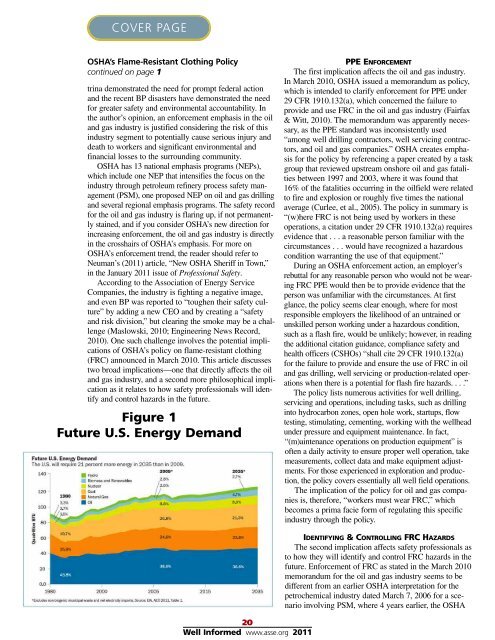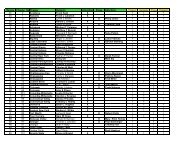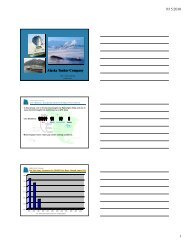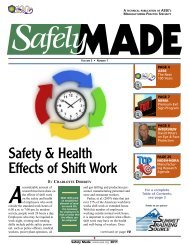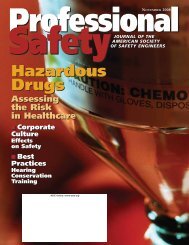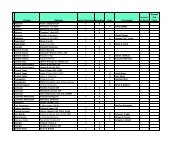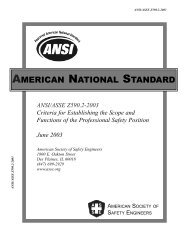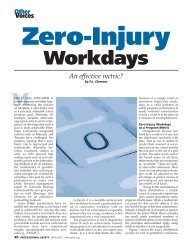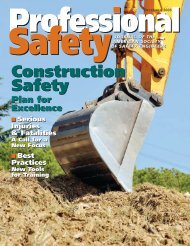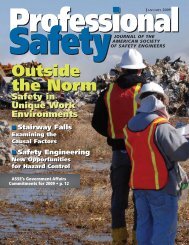COVER PAGEOSHA’s <strong>Flame</strong>-<strong>Resistant</strong> <strong>Clothing</strong> <strong>Policy</strong>continued on page 1trina demonstrated the need for prompt federal actionand the recent BP disasters have demonstrated the needfor greater safety and environmental accountability. Inthe author’s opinion, an enforcement emphasis in the oiland gas industry is justified considering the risk of thisindustry segment to potentially cause serious injury anddeath to workers and significant environmental andfinancial losses to the surrounding community.OSHA has 13 national emphasis programs (NEPs),which include one NEP that intensifies the focus on theindustry through petroleum refinery process safety management(PSM), one proposed NEP on oil and gas drillingand several regional emphasis programs. The safety recordfor the oil and gas industry is flaring up, if not permanentlystained, and if you consider OSHA’s new direction forincreasing enforcement, the oil and gas industry is directlyin the crosshairs of OSHA’s emphasis. For more onOSHA’s enforcement trend, the reader should refer toNeuman’s (2011) article, “New OSHA Sheriff in Town,”in the January 2011 issue of Professional Safety.According to the Association of Energy ServiceCompanies, the industry is fighting a negative image,and even BP was reported to “toughen their safety culture”by adding a new CEO and by creating a “safetyand risk division,” but clearing the smoke may be a challenge(Maslowski, 2010; Engineering News Record,2010). One such challenge involves the potential implicationsof OSHA’s policy on flame-resistant clothing(FRC) announced in March 2010. This article discussestwo broad implications—one that directly affects the oiland gas industry, and a second more philosophical implicationas it relates to how safety professionals will identifyand control hazards in the future.Figure 1Future U.S. Energy DemandPPE ENFORCEMENTThe first implication affects the oil and gas industry.In March 2010, OSHA issued a memorandum as policy,which is intended to clarify enforcement for PPE under29 CFR 1910.132(a), which concerned the failure toprovide and use FRC in the oil and gas industry (Fairfax& Witt, 2010). The memorandum was apparently necessary,as the PPE standard was inconsistently used“among well drilling contractors, well servicing contractors,and oil and gas companies.” OSHA creates emphasisfor the policy by referencing a paper created by a taskgroup that reviewed upstream onshore oil and gas fatalitiesbetween 1997 and 2003, where it was found that16% of the fatalities occurring in the oilfield were relatedto fire and explosion or roughly five times the nationalaverage (Curlee, et al., 2005). The policy in summary is“(w)here FRC is not being used by workers in theseoperations, a citation under 29 CFR 1910.132(a) requiresevidence that . . . a reasonable person familiar with thecircumstances . . . would have recognized a hazardouscondition warranting the use of that equipment.”During an OSHA enforcement action, an employer’srebuttal for any reasonable person who would not be wearingFRC PPE would then be to provide evidence that theperson was unfamiliar with the circumstances. At firstglance, the policy seems clear enough, where for mostresponsible employers the likelihood of an untrained orunskilled person working under a hazardous condition,such as a flash fire, would be unlikely; however, in readingthe additional citation guidance, compliance safety andhealth officers (CSHOs) “shall cite 29 CFR 1910.132(a)for the failure to provide and ensure the use of FRC in oiland gas drilling, well servicing or production-related operationswhen there is a potential for flash fire hazards. . . .”The policy lists numerous activities for well drilling,servicing and operations, including tasks, such as drillinginto hydrocarbon zones, open hole work, startups, flowtesting, stimulating, cementing, working with the wellheadunder pressure and equipment maintenance. In fact,“(m)aintenance operations on production equipment” isoften a daily activity to ensure proper well operation, takemeasurements, collect data and make equipment adjustments.For those experienced in exploration and production,the policy covers essentially all well field operations.The implication of the policy for oil and gas companiesis, therefore, “workers must wear FRC,” whichbecomes a prima facie form of regulating this specificindustry through the policy.20Well Informed www.asse.org 2011IDENTIFYING &CONTROLLING FRC HAZARDSThe second implication affects safety professionals asto how they will identify and control FRC hazards in thefuture. Enforcement of FRC as stated in the March 2010memorandum for the oil and gas industry seems to bedifferent from an earlier OSHA interpretation for thepetrochemical industry dated March 7, 2006 for a scenarioinvolving PSM, where 4 years earlier, the OSHA
Directorate of Enforcement Programs informed theAshland Specialty Chemical Company that it could becited when “. . . the employer has not conducted a hazardassessment” to determine the need to use FRC.OSHA’s response to Ashland was supported by expertiseoffered from two recognized third-party organizations, onefrom the National Fire Protection Association (NFPA) andanother from the Center of Chemical Process Safety(CCPS) under The American Institute of Chemical Engineers(AIChE). In the much earlier Ashland FRC interpretation,OSHA states that enforcement of “(t)he specificstandards related to when industrial personnel must useflame-resistant garments/FRC are found in Chapter 4 (referringto Annex A of NFPA 2113) and include mandatoryrequirements for the selection process and a workplace hazardassessment.” Most safety professionals would agree thatthe Ashland interpretation is consistent with methods appliedby general industry (i.e., the use of a hazard assessment).In the Ashland FRC interpretation, OSHA refers guidancefrom CCPS (quoting OSHA), “. . . PPE is not a primarydefense against hazards. They state that directhazard control through engineering and administrativecontrols must come first. PPE is then used as a supplementalmeasure against hazards” (American Institute ofChemical Engineers, 1992).Both NFPA and AIChE offer methods produced by committeesand professionals that are technically sound andoften reflect participation from a wide cross-section ofindustry (e.g., manufacturer, employer/users, installer/maintainer, labor representatives, applied researchers/test labs,enforcing authority, insurers, consumers and special experts.).From these organizations and others, consensus standardsemerge, such as ANSI/API RP 754, “Process SafetyPerformance Indicators for the Refining and PetrochemicalIndustries,” which was issued in April 2010 in part as aresult of the U.S. Chemical Safety and Hazard InvestigationBoard investigation of the 2005 BP Texas City incident.The oil and gas industry is not only an active participantin such standards, but is often the leader in process safety.Numerous standards pertaining to safety and environmentalprotection exist through the American PetroleumInstitute (API). Hazard assessment is a standardized approachused to identify and control risk and is advocatedby not only the higher-risk industries to which OSHAenforcement efforts are directed, but also by internationallyrecognized consensus organizations (i.e., the subject matterexperts).OSHA continues to validate the hazard assessmentapproach where in the most recent interpretation onthe matter a response is given to the InternationalAssociation of Drilling Contractors (IADC) dated Oct.19, 2010, which states, “When an employer conducts ahazard assessment (HA) per NFPA 2113, Chapter 4, oruses some other method to determine the need for wearingFRC as protection against flash fire hazards, OSHACSHOs will evaluate the adequacy of the HA or othermethods in determining whether to issue citations whereemployees are not provided with, or wearing FRC duringdrilling, well-servicing and production-related operations.OSHA expects employers’ HAs or other methodsused to determine the need for FRC to be comprehensiveand robust.” IADC’s interpretation lists multiple factorsfor consideration of a “comprehensive and robust” hazardassessment, and in particular, this one comment:“Note low-probability/high-consequence eventscan occur when engineering and administrative controlsfail. The recent Deep Water Horizon off-shore drillingplatform event resulted in a massive well blowout,explosion/fire resulting in the death of 11 workers,injuries to other workers and immenseenvironmental damage. Eventhough several investigations are stillongoing, preliminary findings showthat a number of engineering andadministrative controls failed leadingto the incident.”There is no question that protectionof people, our communities andthe environment is of paramountimportance. The question is rather,“What is the appropriate basis ofsafety in which we can work andlive?” Intuitively, decisions need to bebased on “providing an environmentthat is free from recognized hazards”;however, it is the author’s opinionthat recognizing a hazard and theassociated severity and likelihood(i.e., risk) of the outcome is notunderstood by most organizations andrequires specific skills.MANAGEMENT SYSTEMSManagement systems, which advocate hazard identificationand control (e.g., OHSAS 18001, ANSI Z71,RC14001, ISO14001, etc.), are tools that organizationscan use to limit risk. Subsequent to the events in Alaska’sPrince William Sound during the Exxon Valdez spillin 1989, Exxon implemented an operations integritymanagement system, a framework similar to ResponsibleCare® 14001, which consists of 11 elements that createa system to implement safety, security, health, environmentand product safety policies.Exxon has reported that its incident rate per 200,000work hours dropped to 0.35 in 2009 from 0.43 the yearbefore; however, risk management to reduce “everyinjury,” “all hazards” and even “residual risk” requiresadvanced expertise often combining multiple disciplines(e.g., finance, safety, risk, insurance, security, environment,etc.). A low-probability/high-consequence riskresulting in catastrophic proportions, such as the DeepWater Horizon event, is not something that most safetyprofessionals, risk managers and loss prevention professionalscould prevent without a concerted effort amongHazard assessment isa standardized approachused to identifyand control riskand is advocatedby not only the higher-riskindustriesto which OSHAenforcement effortsare directed, but alsoby internationallyrecognized consensusorganizations.21Well Informed www.asse.org 2011


